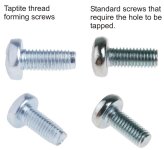Tim Ganz
Member
I have to mount a lot of slotted din rail and just ordered today.
What is the best type and size of screw to use? Course or fine thread?
I am thinking maybe button head with Phillips or allen head but which would be best?
What is the ideal machine thread?
Should I use a flat washer with it?
Should I use a lock washer with it?
What is the best type and size of screw to use? Course or fine thread?
I am thinking maybe button head with Phillips or allen head but which would be best?
What is the ideal machine thread?
Should I use a flat washer with it?
Should I use a lock washer with it?





